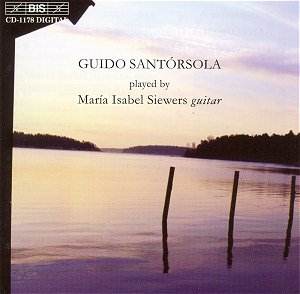In
Maurice Summerfield’s book The Classical Guitar, though
a highlighted composer for the guitar, Guido Santorsola is one
of the few not to be allocated a list of selected recommended
recordings. Although I remember a few radio broadcasts of recitals
by the Abreu brothers and David Russell that included pieces by
Santorsola, availability of recordings by this composer seems
to be thin on the ground. I suspect that this disc may be the
first one entirely dedicated to the guitar works of Santorsola.
A
composer of broad vision, Santorsola was not averse to using past
musical periods for stimulus, "Three Airs of Court"
and "Suite Antiga" are both works in this vein. The
former has its origins in songs found in the French Royal courts
of the 16th and 17th centuries. However
Santorsola’s reworking owes more to a slightly later time, that
of the baroque and in particular the lute works of Bach and Weiss.
"Suite Antiga" is also based on baroque forms, this
time suggesting the Suites of the period but in a somewhat looser
context, without the courante and allemande movements
and with a more modernistic viewpoint.
By
and large, the remaining pieces reflect Santorsola’s background.
Born in Italy, his family moved to Brazil when he was very young
and then later to Uruguay where he became a citizen. It is not
surprising therefore that much of his music bears the hallmarks
of South America, including the Choro and Valsa
forms so popular on that continent, albeit with his own unique
musical style. In some ways his approach is more like Villa- Lobos
than many of the other popular South American composers.
Maria
Isabel Siewers’ playing is competent rather than inspired. I feel
the performances are a little subdued, the slower pieces struggling
to engage the listener although the brisker movements do fare
better. For a disc of just over 75 minutes’ duration Siewers coaxes
virtually no high points in the proceedings, the whole affair
being very one dimensional. It may well be that this music requires
a guitarist of unusual insight to bring it off well. This may
explain the rarity of recordings by this composer. With all respect
to Maria Isabel Siewers I would dearly love to hear this music,
which I feel promises so much, in the hands of a guitarist like
David Russell, or Jason Vieaux.
Mention
should be made to Daniela Canale who gives good support as a duettist
in the "Concertino" which Maria Isabel Siewers has reworked
from Santorsola’s original for guitar trio.
Andy
Daly
